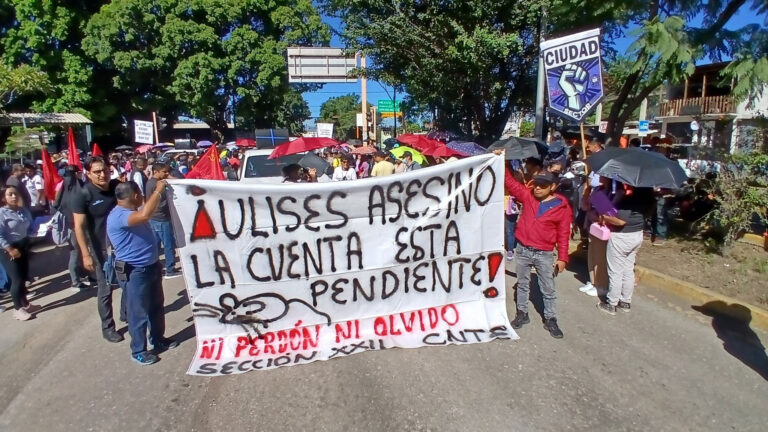CNTE SUBMITS GOVERNMENT’S 5 POINT PLAN TO MEMBERSHIP
This article by Laura Poy, Alexia Villaseñor and Néstor Jiménez appeared in the May 29, 2025 edition of La Jornada, Mexico’s premier leftist daily newspaper.
What are the CNTE’s Demands?
Immediate repeal of the 2007 ISSSTE Law; restoration of a solidarity-based, collective, and intergenerational pension system; the full recognition of retirement based on years of service (28 for women and 30 for men) instead of the age of 65; the payment of pensions based on the minimum wage rather than on UMAs; the elimination of AFOREs as a privatization model (AFOREs are private companies who manage pensions as individual accounts, extremely restrictive and profitable for finance capital); and a profound restructuring of ISSSTE to restore its social character.
Upon reinstating the dialogue table with the federal government, the leadership of the National Coordinator of Education Workers (CNTE) announced that it will submit the five-point proposal presented by the federal government to the teaching ranks in state assemblies. This proposal includes, among other aspects, a freeze and gradual reduction of the retirement age.
That is, the retirement age for teachers would be reduced by one year every three years. In 2028, men will be able to retire at 57 and women at 55. This proposal would extend until 2038, explained teacher Yenny Aracely Pérez, general secretary of Section 22 of Oaxaca and a member of the Single National Negotiation Commission (CNUN).
Furthermore, the proposal signed by the Secretaries of the Interior, Rosa Icela Rodríguez, and Public Education, Mario Delgado, and the Director General of the Institute of Social Security and Services for State Workers (ISSSTE), Martí Batres, includes the creation of an interdisciplinary group to study alternatives to social security schemes for state workers.
Another point is the abolition of the Teachers’ Career System Unit (Usicamm), in order to continue strengthening labor rights and the role of teachers as agents of transformation. The establishment of tripartite committees and the creation of a retirement system registry are also proposed.
The negotiating table lasted more than five hours at the Cobián Palace. Afterward, at a press conference, Pedro Hernández Morales, general secretary of Section 9 of Mexico City, emphasized that the document presented to the CNTE includes a declaration in which the federal government expresses its respect for their organization and methods of struggle. “We will always maintain our commitment to free expression and demonstration, without any type of repression,” the professor noted, translated, “that is, no administrative or other type of repression will be appropriate.”
The leaders of the coordinating body emphasized, “at the dialogue table, we made it very clear that the CNTE is an organization with political and ideological independence, and that we have been fighting for 45 years: we do not accept being compared to the right or the far right.”
They also reiterated that the teachers mobilizing since May 15 did not take to the streets to boycott the judicial elections of June 1. “Our demand is very specific: repeal of the 2007 ISSSTE Law. We are not demanding an additional week of vacation or golden letters in the Senate.”
Isael González Vázquez, general secretary of Section 7 of Chiapas, insisted that “the CNTE has demonstrated political will, which is why we responded to the call from the Ministry of the Interior, but we reiterated to federal officials that we want a meeting with President Claudia Sheinbaum Pardo. And we made it clear that the CNUN has not accepted anything. Everything will be up to our base to discuss,” he stated, after confirming that the dialogue table with the federal government remains open. The leaders announced that their National Representative Assembly would meet early this morning.
This morning, thousands of teachers affiliated with the coordinator blocked strategic points in Mexico City for more than six hours, from the National Auditorium to the Caballito Tower, to support the negotiating table.
On the fourteenth day of their national strike, education workers marched in a swarm from the sit-in protest that had been in place in the capital’s Zócalo since May 15. Starting at 10 a.m., they arrived at various locations including Circuito Interior, Estela de Luz, the Angel of Independence, and the Diana Cazadora, Ahuehuete, and Mujeres que Luchan roundabouts.
Traffic was disrupted in the center lanes of Paseo de la Reforma and on the surrounding streets, where honking and protests were constant, and thousands of people had to travel on foot.
Each contingent brought a sound cart with which they expressed their demands or gave out announcements to organize. As on other occasions, the teachers were prepared to endure days of protest lasting several hours. They brought folding cloth chairs, colorful collapsible benches, and tarps to tie to trees and poles to protect themselves from the sun. Others brought containers of fruit and food to endure the wait.
At the conclusion of the informational meeting, held shortly after 5 p.m. at the corner of Bucareli and Paseo de la Reforma, hundreds of teachers returned to the protest.
-
CNTE Will Strike, Protest in 2026 so President Sheinbaum Keeps Promise to Repeal Calderón’s ISSSTE Law
The teachers union will mobilize to ensure the Mexican President honours her 2024 campaign promise.
-
CNTE Sets Up Protest Outside Mexico’s Chamber of Deputies
The CNTE teachers’ union leadership pointed out that the federal government “has only offered delaying tactics; its statements are far from the reality experienced by thousands of teachers throughout the country.”
-
CNTE Teachers Thwart Right Wing Party Assembly
Teachers from Valles Centrales disrupted a political event orchestrated for a new party being formed by ex-governor of Oaxaca Ulises Ruiz Ortiz , responsible for repression against teachers in 2006 which led to 20 murders & multiple disappearances.




